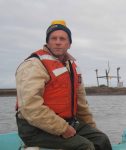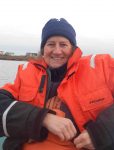Sikuliaq cruise to study marine life response to Arctic upwelling
August 18, 2017
Diana Campbell
907-322-7686
University of Alaska Fairbanks researchers will begin an Arctic research cruise this
month to study how winds in the Beaufort Sea affect the food chain, from plankton
to whales.

UAF researcher Steve Okkonen will join chief scientist Carin Ashjian of Woods Hole Oceanographic Institution, along with scientists studying plankton, fisheries and marine mammals, aboard the research vessel Sikuliaq for a three-week cruise.
The research group will examine the way microscopic plankton are concentrated by water upwelling along the Beaufort shelf break, where the continental shelf ends and the deep ocean basin begins. Upwelling in the southern Beaufort Sea occurs when easterly winds drive surface water to the north. Deeper water moves up to replace it, bringing plankton toward the surface in large concentrations.
The researchers want to see if plankton concentrations attract Arctic cod to the shelf break in large enough numbers to provide abundant prey for beluga whales and other marine animals. The researchers will also watch seabirds and other marine life feeding in the area.

The researchers hypothesize that the wind-forced upwelling provides abundant plankton that draw fish, whales, seals and seabirds. Some of these species are important to northern subsistence hunters.
The scientists want to share the research story with the public, particularly with Alaskans, and will offer a Facebook page, Arctic Winds, Fish, Fins and Feathers, as well as Instagram (@ArcticWFFF), Snapchat (arcticwfff), and Twitter (@arctic_wfff). Please look for the hashtag #ArcticWFFF, as well. A teacher on board will post items for schools and educators here.
Researchers from the University of Washington, the University of Rhode Island, and the U.S. Fish and Wildlife Service will also participate in the project.
The research crew is scheduled set sail from Nome on Aug. 25 and return there on Sept. 18. The Sikuliaq is owned by the National Science Foundation and operated by the College of Fisheries and Ocean Sciences at UAF, as part of the U.S. academic research fleet. It is used by scientists in the United States and their international collaborators through the University-National Oceanographic Laboratory System.
The Sikuliaq’s position can be followed in real time here.


